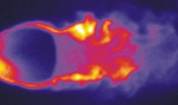| |
Nitric Oxide Planar Laser-Induced Fluorescence (NO PLIF)
Planar laser-induced fluorescence, or PLIF, is a non-intrusive flow diagnostic tool that can acquire planar snapshots of flow in wind tunnels, engines, and other flow systems. In addition to serving as a flow visualization technique, PLIF can also measure gas-dynamic properties such as velocity, temperature, pressure, mole fraction, gas density or species concentration. PLIF images are obtained by using a laser to excite a molecular species present in a flow. This species either occurs naturally or can be seeded. Commonly used species include NO, OH, iodine, and acetone. The resulting fluorescence is imaged with a scientific grade camera. The resulting flow visualizations and quantitative measurements are commonly used to compare with computation fluid dynamics (CFD) codes. The temporal resolution of this measurement system is typically better than 1 microsec while spatial resolution is approximately 200 microns. Langley has developed a portable PLIF system that can be brought to different facilities at Langley as well as to facilities elsewhere in the United States.

Primarily we have used NO PLIF to visualize the transition from laminar to turbulent flow, which is a critically important and poorly understood process that affects many different space vehicles including the Space Shuttle Orbiter and Crew Exploration Vehicle. We are currently developing and applying temperature, velocity and pressure imaging methods using NO PLIF. Examples of NO PLIF images are shown on the following page. The PLIF images have been superimposed upon computer renderings of the actual models tested in the wind tunnel.
|




